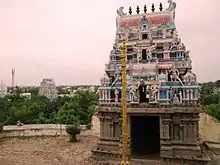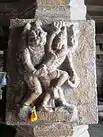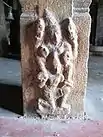Uyyakondan Thirumalai Temple
Uyyakondan Thirumalai Temple (also called Ujeevanathar temple, Karkudimalai or Thirumalainallur[2])) is a Hindu temple dedicated to the deity Shiva, located on the banks of Uyyakondan river, Trichy, in the South Indian state of Tamil Nadu. Shiva is worshipped as Uyyakondan, and is represented by the lingam. His consort Parvati is depicted as Anjanakshi Amman. The presiding deity is revered in the 7th century Tamil Saiva canonical work, the Tevaram, written by Tamil saint poets known as the Nayanars and classified as Paadal Petra Sthalam.
| Uyyakondan Thirumalai Temple | |
|---|---|
 | |
| Religion | |
| Affiliation | Hinduism |
| District | Tiruchirapalli |
| Deity | Ujjevanathar, Anjanakshi Amman[1] |
| Location | |
| Location | Tiruchirapalli |
| State | Tamil Nadu |
| Country | India |
| Geographic coordinates | 10°48′57″N 78°39′33″E |
| Architecture | |
| Type | Dravidian architecture |
| Creator | Chola kings |
The temple complex covers four acres, constructed on a hillock 30 m (98 ft). The temple has a number of shrines, with those of Uyyakondar and his consorts Maivizhi and Kanniyumaiyal, being the most prominent. All the shrines of the temple are enclosed in large concentric rectangular granite walls. The temple is approached by a flight of steps from the basement that houses the temple tank.
The temple has four daily rituals at various times from 6:00 a.m. to 8:30 p.m., and four yearly festivals on its calendar. The Brahmotsavam festival is celebrated during the day of the Magam (February - March) is the most prominent festival.
The original complex is believed to have been built by Cholas. In modern times, the temple is maintained and administered by the Hindu Religious and Charitable Endowments Department of the Government of Tamil Nadu. The temple has inscriptions from the Chola period.[3]
Architecture
The temple is located on a rock about 30 metres (98 ft) tall and is surrounded by granite walls.[3] The temple is reached by a flight of steps. The shrine of Vinayagar is located in a cut in the first ten steps and the other shrines are located on the hillock. The whole temple is fortified and the temple tank is located inside the fortification.[3] The temple is built in Sembian age of Cholas around 950 CE.[4] The main deity of the temple faces western direction.[1] There are two shrines of Goddess in the temple.[1]
Legend
A Sri Lankan king is believed to have been blessed by the deity here.[5]
History
The temple has inscriptions dating from Kulothunga Chola I (1070–1118 CE), that speaks of a separate community known as Rathakarar, a sect of expert carpenter skilled in the art of designing and making temple cars.[6] The temple was occupied by French and English forces during the siege of Trichonopoly (old Tiruchirapalli) in 1753-54.[3] After the war battle of Sugar-loaf rock, English Major Lawrence marched against the fortified temple and carried it by assault.[3]
Literary mention
The temple is revered in the 7th–8th century Saivite canonical literature, Tevaram, by all the three poets, namely, Appar, Campantar and Cuntarar.[1]
வடந்திகழ் மென்முலை யாளைப் பாகம தாக மதித்துத்
தடந்திரை சேர்புனல் மாதைத் தாழ்சடை வைத்த சதுரர்
இடந்திகழ் முப்புரி நூலர் துன்பமொ டின்பம தெல்லாங்கடந்தவர் காதலில் வாழுங் கற்குடி மாமலை யாரே
[7] Cuntarar describes the feature of the deity as:
விடையா ருங்கொடியாய் வெறியார்மலர்க் கொன்றையினாய்
படையார் வெண்மழுவா பரமாய பரம்பரனே
கடியார் பூம்பொழில்சூழ் திருக்கற்குடி மன்னிநின்றஅடிகேள் எம்பெருமான் அடியேனையும் அஞ்சலென்னே.
Festivals
The temple priests perform the puja (rituals) during festivals and on a daily basis. The temple rituals are performed four times a day; Kalasanthi at 8:00 a.m., Uchikalam at 12:00 a.m., Sayarakshai at 6:00 p.m, and Arthajamam at 9:00 p.m.. Each ritual comprises four steps: abhisheka (sacred bath), alangaram (decoration), naivethanam (food offering) and deepa aradanai (waving of lamps) for Kachabeswarar and Anjanatchi. There are weekly rituals like somavaram (Monday) and sukravaram (Friday), fortnightly rituals like pradosham, and monthly festivals like amavasai (new moon day), kiruthigai, pournami (full moon day) and sathurthi. The nine-day Brahmotsavam during the Tamil month of Masi and Shivaratri are the most important festivals of the temple.[9][10]
Notes
- "Tourist Places". Government of Tamil Nadu. 2001.
- Sewel 1882, p. 269
- Madras 1907, pp. 341–342
- Dehejia 1990, p. 101
- Ayyar 1991, p. 247
- A. 1987, p. 36
- Campantar, p. 101
- Cuntarar, p. 49
- "Sri Aludayar temple". Dinamalar. 2014. Retrieved 24 November 2015.
- R., Dr. Vijayalakshmy (2001). An introduction to religion and Philosophy - Tévarám and Tivviyappirapantam (1st ed.). Chennai: International Institute of Tamil Studies. pp. 174–5.
References
- A., Kuppuswami (1987), The Crest Jewel of Divine Dravidian Culture, Pudukottai: Sarma's Sanatorium Press.
- Ayyar, P. V. Jagadisa (1991), South Indian shrines: illustrated, New Delhi: Asian Educational Services, ISBN 81-206-0151-3.
- Dehejia, Vidya (1990), Art of the imperial Cholas, USA: Columbia University Press, ISBN 0-231-07188-4.
- F.R., Hemingway (1907). Madras district gazetteers, Volume 1. Superintendent, Government Press.
- Swamigal, Campantar. "Tevaram Of Campantar Cuvamikal Tirumurai 1 - 1 Poems(1-721)" (PDF). Projectmadurai.org. Retrieved 8 February 2012.
- Swamigal, Cuntaramurthi. "Tevaram Of Campantar Cuvamikal Tirumurai 7 - Poems(1-517)" (PDF). Projectmadurai.org. Retrieved 8 February 2012.
- Sewell, Robert (1882). Lists of the antiquarian remains in the presidency of Madras. E.Keys, Government Press.



